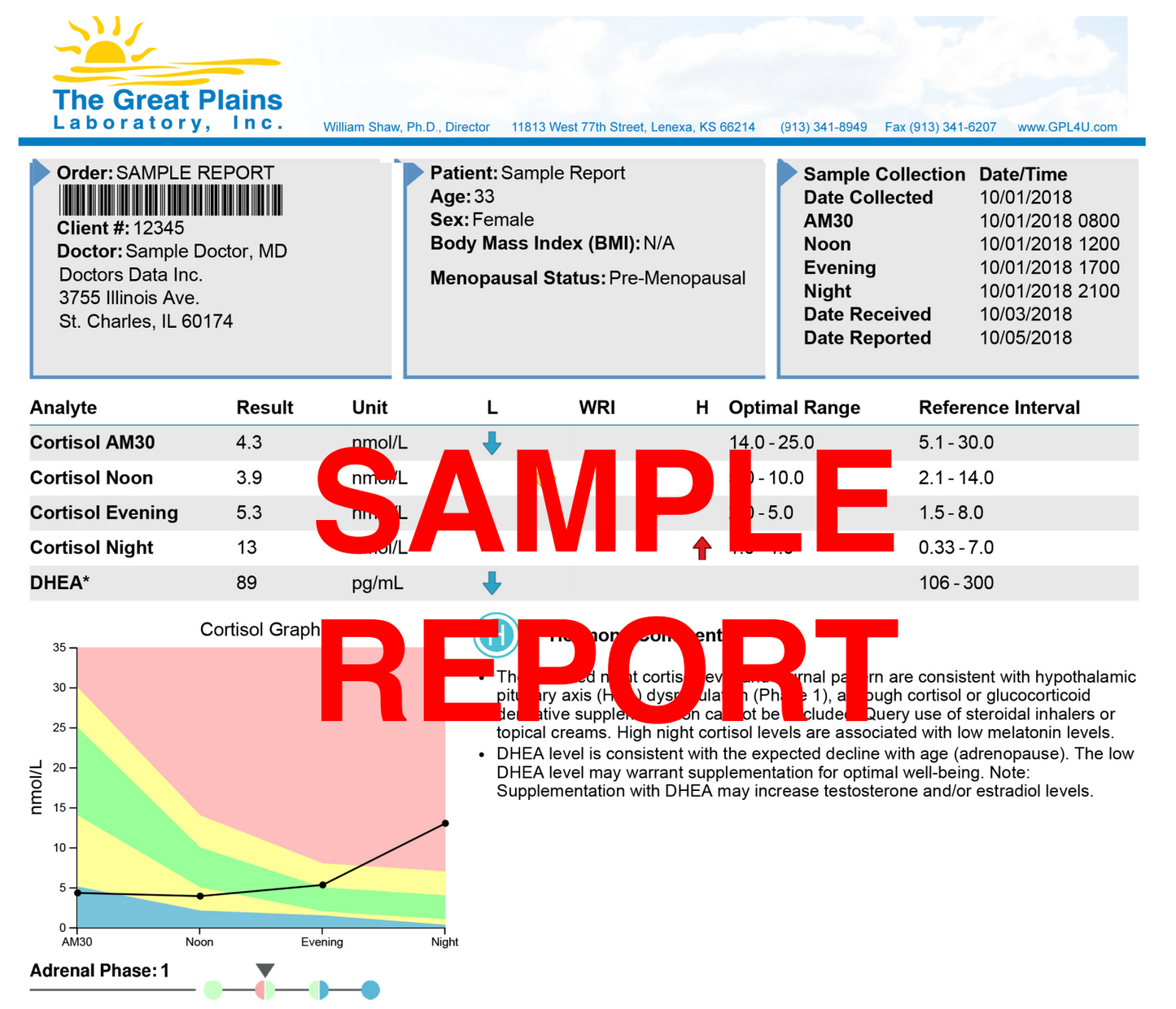1
/
of
3
Mosaic Laboratory - (The Great Plains)
Male Hormones Test (saliva)
Male Hormones Test (saliva)
Regular price
$299.00 USD
Regular price
Sale price
$299.00 USD
Unit price
/
per
Shipping calculated at checkout.
Share
Couldn't load pickup availability
Along with Nutrition Consultation you can check your Hormone level using convenient test kit.
MALE MARKERS TESTED:
Estradiol (estrogen), Progesterone, Testosterone, DHEA, Cortisol (4х a day).
SPECIMEN REQUIREMENTS: Specimen Type: Saliva 3/4 Tube Full x 4
TURNAROUND TIME: 1-3+ weeks.
Note! Laboratory does NOT accept specimens from patients who reside in or practitioners who practice in the state of New York.
View full details


ABOUT SALIVA HORMONE TEST
Collapsible content
About saliva test
Saliva testing is the most convenient and least invasive manner to measure patients' hormone status, as saliva measures the body's "free" hormone levels. Clinically, the free hormone is considered to be the active hormone available for use by tissue. Thus, it is far more relevant to test the amount of hormones delivered to the tissue receptors, as this is a reflection of the active hormone levels within the body.
THE BENEFITS OF SALIVA
There are two types of hormones — bound and unbound — that circulate throughout the blood. Approximately 95 percent of hormones are bound, meaning they are bound by proteins and are therefore not available for tissue use. These bound hormones are too large to pass through the salivary glands and therefore cannot be measured by saliva. The remaining 5 percent of hormones are unbound and do not bind to protein, remaining active and fully available for tissue use. These hormones are able to pass through the salivary gland.
DIFFERENCES BETWEEN ANALYZING SERUM AND SALIVA
It is often difficult for healthcare providers to assess accurate hormone levels with serum, which makes it even more difficult to design a hormone replacement therapy for patients. Serum contains both bound and unbound hormones, yet a reliable method to identify an accurate ratio between these different hormones has yet to be determined.
Saliva, however, provides an accurate level of unbound hormones available in circulation. This is commonly a much lower value in comparison to serum, as it only assesses free hormones. When clinicians utilize saliva to measure effectiveness, they often find that it is higher than serum, indicating a decrease in hormone replacement therapy is necessary. By strictly using serum, clinicians have found that they needed to give excessive amounts of hormone therapy in order to cause an increase in serum hormone levels.WHY SALIVA IS A
MORE EFFECTIVE WAY TO ASSESS HORMONE REPLACEMENT THERAPY
Serum measures both bound and unbound hormone levels. A valid test has yet to be developed that is able to both deliver a true ratio of bound versus unbound hormones and be applicable to each individual. Another downfall with using serum to measure a patient's baseline and effectiveness of hormone therapy is that serum is typically taken once a day. However, in order to get an accurate idea of the baseline and therapy, measurements would need to be assessed at different time periods throughout the day because the body secretes hormones in a pulsatile fashion. Conversely, saliva only measures unbound hormone levels, and can thus be assessed four times daily.
The discrepancy between free and protein bound hormones becomes especially important when monitoring topical, or transdermal, hormone therapy. Studies show that this method of delivery results in increased tissue hormone levels (thus measurable in saliva), but no parallel increase in serum levels. Therefore, serum testing is not a reliable method to measuring hormone therapy.
Why test hormones
Hormones are essential for our overall welfare. We frequently think of estrogen as being a female hormone, and testosterone as being a male hormone. But both men and women make both, plus several more must be in balance for optimum health. An imbalance of any one hormone can throw physical and mental health out of balance, causing aggravating and even serious health problems.
For decades western medicine has prescribed Hormone Replacement Therapy as a "one size fits all" approach. However, nothing could be further from the truth. Hormones are like fingerprints, and in order to achieve optimal health, people must be aware of their specific imbalances.
Being able to identify a hormonal imbalance is essential to design an effective treatment plan. If a patient is seeking bio-identical hormone replacement therapy (BHRT) or a topical therapy, free hormone levels must first be assessed before proceeding with a particular therapy.
Who should be tested?
Men and women at any age who display symptoms of hormone imbalance such as:
-
Men and women concerned with changing hormone levels as a result of age
-
Cycling women experiencing PMS symptoms, perhaps related to a hormonal imbalance
-
Peri and post-menopausal women concerned with their estradiol and progesterone levels for replacement considerations
-
Those wishing to monitor their hormone levels following replacement therapy (oral, sublingual or topical), and subsequently regulate their supplement levels
-
Anyone with symptoms involving fatigue, insomnia, stress, immunity problems, blood sugar problems, and overweight should be tested for cortisol levels as well as "sex" hormones
As we age, our hormonal makeup will begin to change as well, therefore it is ideal to understand where the imbalances are and identify an optimal therapeutic plan. Both men and women should perform a baseline test as a proactive step in maintaining physical and mental health, as imbalances may be present before symptoms manifest.
Which hormone should be tested?
The major sex hormones to assess are estradiol, progesterone and testosterone. Estrone and estriol are also important sex hormones to consider testing. The main adrenal hormones are DHEA and cortisol. These seven hormones provide crucial information about deficiencies, excesses and daily patterns, which then result in a specifically tailored treatment approach and one far more beneficial than the old "shotgun" approach. Below is a brief description of each of these hormones:



